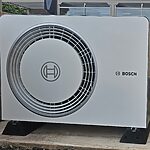Scottish Borders ASHP
Hello,
We are currently upgrading windows and insulation as well as improving draughtproofing on our 100 year old stone semi detached house. Meanwhile we are getting quotes for an ASHP with UFH downstairs.
Reading this forum I'm pretty sold on getting a Mixergy tank. Can anyone advise on what size a Mixergy tank would be required when a 200l normal tank would be usually specified? We are a family of 4 with one shower/bath. Some installers seems reserved about fitting a third party tank.
We need some electrical work done as well. Has anyone had their main fuse upgraded to accommodate an ASHP? What other electrical stumbling blocks might we encounter?
We currently have a mains gas combi which is very underwhelming in the cold months. The radiators throughout the house don't cut it either. Very small bore pipes leading off main pipes from the boiler.
The majority of the ground floor is suspended timber floor which we intend to insulate and then have the UFH installed, board and tile/engineered wood over. Reading this forum, Stelrad K3 compact rads seem like a good choice upstairs.
I'm thinking we will need lots of new pipe work to reduce the work on the pump as the current feed to the rads is so small. Did you use mostly plastic or copper pipe on your system? This seems to be fairly important due to the difference in internal diameter. What diameter pipe did you have installed?
Our EPC report says that our demand is 25,665kWh for space heating and 2,000KWh for hot water per year.
The goal is to eliminate gas from our home and hopefully generate some of our own electricity through solar. We hope to drive down energy costs in the long run. Is there further heat loss calculations you would recommend?
Thank you to all who contribute to this forum, its a wealth of knowledge and ideas.
@Gordonville, it sounds like you're going to end up with a completely new system, which it what we had. We started with no central heating at all. UFH works well with an ASHP but you don't need it. It is a different sort of heating and is also quite expensive to install so don't discount radiators. We used all standard 15mm copper pipes in our system.
Our fuse was OK as it was, because our supply was previously running 8 storage heaters. You do need to ask your Distribution Network Operator (DNO) before you install a ASHP; they will tell you whether the incoming supply is up to it (it probably will be). Upgrading the fuse is then not a big job if needed.
That's quite a high heat demand for a semi but hopefully your insulation work will reduce it. You will end up paying more than with gas but I'm sure you know that.
You can download the MCS heat loss calculator here.
https://mcscertified.com/mcs-launch-new-improved-heat-pump-calculator/
Do check the permitted development rules for ASHPs as the Scottish ones are a little more restrictive on where you can site the ASHP.
Good luck and keep us up to date with progress.
@gordonville, the one thing that I can comment on, and that you've already highlighted, is the bore and rad size. It took us a while to get the bottom of why the southern end of the house wasn't coming to temperature and we finally ascertained that the reduced pipework work from the utility room where our tank is to the southern portion of the house was causing the issues, so the upgrade to K3 rads from Stelrad was a game changer. The true test is still coming, but I'm confident we'll be far warmer this winter.
Have you received any quotes yet, and do you have a brand preference at this stage?
Get a copy of The Ultimate Guide to Heat Pumps
Subscribe and follow our YouTube channel!
Thank you for the replies. That MCS heat loss calculator looks like a really powerful tool. I’m kind of concerned that neither of the quotes we have had go in to such detail.
We had one quote for a Vaillent 12kW high temp unit and tank with UFH.
Another quote was for a Nibe F2040 12kW with Telford tank and UFH.
Both came in at just over 20K. Seems like too much. We are learning as we go and this forum really helps with that.
I used the EST search bar to fire out loads of further quote requests and have had a couple of replies. It has helped me get the appropriate information together. Lots of companies seem very busy. There is probably a shortage of parts at the moment too.
In terms of brands I do like the idea of Nibe but they seem much more expensive and I wonder what you really get for that extra cash.
I like that they are heat pump specialists and have been in business for a good amount of time. Being Scandinavian made also appeals to me.
I am wary of standard boiler manufacturers coming out with heat pumps. This is perhaps in justified. Honestly, I don’t know which brand would be the best balance of cost/performance/warrenty etc. What is your views on this? Most installers probably have a preferred brand and most customers probably prefer their own install i guess.
I have an electrician coming round soon to look at a rewire so hopefully he will help with the DNO. I’ll attach a picture of the incomer here. Nothing on it to say what the rating currently is.
As for the UFH, I do like our floorboards. To properly insulate the house I think these will have to be lifted anyway. I’m not totally against the rads idea though. The worry is that they will have to huge but maybe that is an old way of looking at it.
@gordonville Both are good units, the Valiant controller is very complicated whilst the Nibe unit is much easier to operate and has a built-in online connected through Wi-Fi. I have installed both, but prefer the Nibe unit. (they are similar in price at source and both have excellent backup)
The installers should, according to MCS supply you with full room by room heat loss calculations with an emitter schedule (under floor or radiators) stating the flow temperature at the design temperature (around -3 or -4 for you), It must also include evidence that the heat pump will supply sufficient energy at this temperature without assistance as air source heat pumps loose performance and output at lower temperatures.
If the installers cannot supply this, look for another one.
Correctly sized radiators can supply excellent performance and comfort, but the design temperature should not be greater than 45 Deg C. Under floor should have a design flow temperature of 35 Deg C, a pipe spacing of 100mm usually suffices.
We are very busy at the moment, there is generally not a problem with supply, but people are tying to get the installations done before the RHI finishes in March next year, we have customers that we quoted 3 years ago now requesting installations.
I hope this helps.
@gordonville I posted the heat loss calculator and ASHP selector from freedom heat pumps on here a while ago. Have a look, it should help you in cross checking any quotes
-
How to Understand Wiring Up a Heat Pump
3 months ago
-
How to Zone with a Single Room with UFH
4 months ago
-
UFH and ASHPs
8 months ago
-
Heat Pump, DHW, UFH and Radiator Install
1 year ago
-
Retrofitting UFH with a heat pump already installed
2 years ago
- 26 Forums
- 2,381 Topics
- 54 K Posts
- 333 Online
- 6,065 Members
Join Us!
Worth Watching
Latest Posts
-
Hi, Just wondering is there any app on my phone i can...
By newhouse87 , 37 seconds ago
-
RE: Installer Fitted 9kW Instead of 11kW Heat Pump and Changed MCS Paperwork - What do I do?
Well, no major progress to report as yet. HIES replied ...
By MairiA , 8 minutes ago
-

This thread looks fun, and I'm now wondering if changin...
By Steelbadger , 36 minutes ago
-

RE: Solar Power Output – Let’s Compare Generation Figures
You're right @bash - every G99 application gets assesse...
By Transparent , 43 minutes ago
-
Advice for a novice on Mitsubishi Ecodan 6kW
Hello all, I am very much hoping to draw on the e...
By Green_Fox , 1 hour ago
-
RE: Advice on Vaillant Sensocomfort
@jamespa Hi Jamespa, I have all of those - A SensoComfo...
By dr_dongle , 1 hour ago
-
RE: Recommended home battery inverters + regulatory matters - help requested
It's not actually essential that your inverter and batt...
By Bash , 1 hour ago
-
RE: Say hello and introduce yourself
Thanks @jamespa. Much appreciated. I've read that Intro...
By Green_Fox , 2 hours ago
-
RE: Insulating a pitched roof with kingspan, has anyone done it?
As you have maximum floor insulation, there will be lit...
By AgentGeorge , 4 hours ago
-

RE: New Fogstar 15.5kWh upright solution
Erm... how can @jancold post new links? It's you @bat...
By Transparent , 4 hours ago
-
RE: Octopus Cosy Heat Pump Owners & Discussion Thread
You are doing well in January. Dec COP with my Vaillan...
By JamesPa , 5 hours ago
-
RE: Gen 6 Samsung ASHP losing 20C of DHW in 60 min directly after generation
That was what confused me! The heat pump FT is doing w...
By JamesPa , 7 hours ago
-

@renewables345 — thank you for the clarification. I'm r...
By cathodeRay , 7 hours ago
-
RE: Connecting Growatt SPH5000 over wired ethernet rather than wireless
Well well well.. turns out my WiFi dongle is actually t...
By z8lccda , 19 hours ago
-
RE: Solis S6-EH1P8K-L-PLUS – Why I Chose It and What I’ve Learned So Far
I am now considering adding a second battery to my setu...
By Batpred , 20 hours ago
-

@abam48 Did you go for this option and does it work wel...
By dgclimatecontrol , 23 hours ago
-
RE: Weather compensation- why you should use it
Okay thanks both. Yes the house is very nic...
By jamesh , 1 day ago
-
RE: Cascade 2x Grant Areona 10kw ASHP - Ongoing setup issues
Well this morning the master bedroom & ensuite were...
By adam , 1 day ago
-

RE: Setback savings - fact or fiction?
That is correct, the setback period was Feb to Apr 2025...
By cathodeRay , 1 day ago
-
RE: Havenwise App Help & Forum Support – Get the Most from Your Heat Pump
Fair enough. The reason for asking was that Henri's po...
By Sheriff Fatman , 1 day ago





